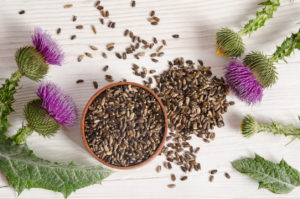Hot flashes and/or night sweats, collectively called vasomotor symptoms (VMS), are the most common symptom of perimenopause/menopause. The average duration of VMS is about 7 years, so more options to address this frequently significant symptom, are always welcomed. While VMS can come in all sizes and shapes, varying from mild to severe and infrequent to frequent, they are bothersome enough for a large number of women, interrupting sleep, altering mood and affecting her quality of life.
 This trial of milk thistle was conducted in Iran between September 2018 and December 2019. Women were postmenopausal between the ages of 40 and 60 years, and who had experienced VMS ≥ 14 times weekly for the past two months, and who had a total Greene Climacteric Scale (GCS) score between 15 and 42 and a Hot Flash Related Daily Interference Score (HFRDIS) ≥ 40.
This trial of milk thistle was conducted in Iran between September 2018 and December 2019. Women were postmenopausal between the ages of 40 and 60 years, and who had experienced VMS ≥ 14 times weekly for the past two months, and who had a total Greene Climacteric Scale (GCS) score between 15 and 42 and a Hot Flash Related Daily Interference Score (HFRDIS) ≥ 40.
Women were excluded if they used tobacco, had an underlying chronic disease, history of allergy to herbal medicines, use of other treatments to treat hot flashes, history of asthma and allergies, history of abnormal pap smears and pelvic ultrasounds, and history of a breast, ovarian or uterine cancer.
A dry extract of milk thistle in the form of a powder was encapsulated with 400 mg per capsule of milk thistle standardized to 80% silymarin. Eighty women were randomized into two even groups, and each group took a 400 mg capsule twice a day for eight weeks – one group milk thistle and one group placebo. Women recorded the frequency and severity of hot flashes for twelve weeks including the four weeks after stopping the capsules. Data was collected every four weeks with a visual analog scale to evaluate the severity of hot flashes; women reported the average of their frequency and severity for each day.
The GCS was used to measure menopausal symptom severity and HFRDIS assessed the vasomotor interference level during their daily activities. The mean age of women in the study was 52.5 years. Seven dropped out of the study; two from the milk thistle group five from the placebo group due to gastric pain, bloating, and increased symptoms.
The women in the milk thistle group reported a decrease in the frequency and severity of hot flashes, while the placebo group saw no significant changes. The GCS questionnaire mean score and HFRDIS mean scores decreased in the milk thistle group while the placebo group had no significant changes. The conclusion was that the milk thistle reduced postmenopausal VMS within the first month and lasted a month after discontinuation as well.
Commentary: We still do not know the exact mechanism for VMS, but the most recent thinking is that there are abnormalities in the hypothalamic thermoregulatory center due to fluctuating estrogen levels and ultimately lower estrogen levels.
The primary conventional treatment for VMS includes estrogen therapy, but other therapies such as SSRIs, gabapentin, a selective estrogen receptor modulator (SERM) in combination with an estrogen and clonidine. There are a host of botanical and nutrient therapies that have published research. The conventional pharmaceuticals all have benefits and risks, with hormone therapies having the most benefits, with very small risks in most women. The botanical/nutraceuticals have benefits and small to no risks, although the benefits for VMS do not statistically meet the same level of results as with systemic estrogen. That said, what we care most about is what are the individual benefits and risks for each woman and the individual results she achieves with her treatment, whatever the treatment is.
I am most familiar with the use of Milk thistle (Silybum marianum, Asteraceae) for liver and gallbladder conditions, but there are other historical uses for fever, kidney and spleen diseases.
The active constituents of milk thistle seeds are three isomeric flavonolignans, namely silibinin (silybin), silychristin, and silidianin, could have an agonistic effect on estrogen receptor b, or one might also theorize it is affecting serotonin receptors via the gut/brain axis.
Reference: Saberi Z, Gorji N, Memariani Z, Moeini R, Shirafkan H, Amiri M. Evaluation of the effect of Silybum marianum extract on menopausal symptoms: A randomized, double-blind placebo-controlled trial. Phytother Res. December 2020;34(12):3359-3366.

